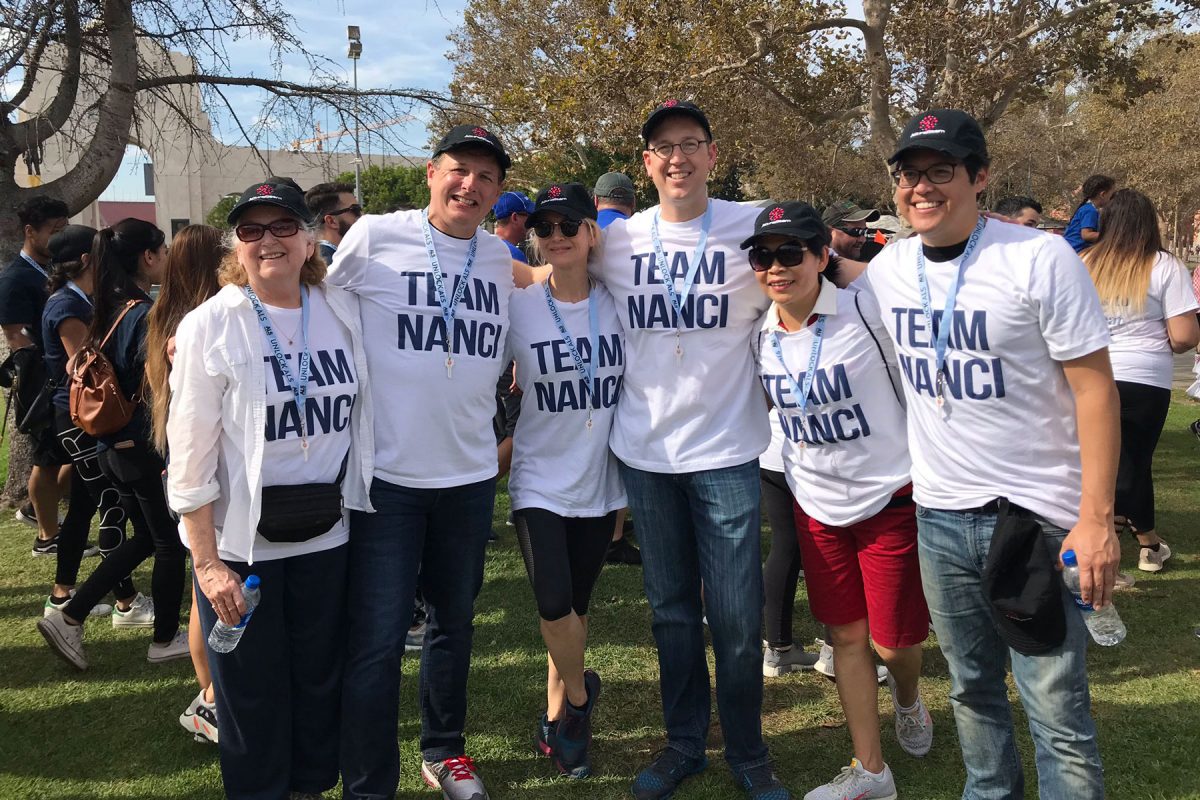
Justin Ichida keeps his research patient-based. That’s why Ichida, Richard N. Merkin, M.D., Assistant Professor of Stem Cell Biology and Regenerative Medicine at the Keck School of Medicine of USC, and his startup company AcuraStem participated in the ALS Association Golden West Chapter Walk to Defeat ALS at Exposition Park in Los Angeles.
The group walked alongside Team Nanci in November in support of Nanci Ryder, a prominent Hollywood publicist diagnosed with ALS—amyotrophic lateral sclerosis, also known as Lou Gehrig’s disease. Ryder and actress Renee Zellweger, a friend and client of Ryder’s, have taken interest in Ichida’s work.
“[AcuraStem is] really living its mission of being patient-based from the beginning to the end of the drug development process,” said AcuraStem’s director of communications, Kissy Black. “It’s not just a team of researchers who study ALS in their lab: the team goes beyond the bench to connect with ALS patients and participate in events to raise money for, and awareness of, the disease.”
According to the National Institute of Neurological Disorders and Stroke, ALS is a rapidly progressive, fatal disease that affects the nerve cells—neurons—in the brain and spinal cord that control voluntary muscle movement. Individuals affected by the disease experience gradual deterioration and death of these neurons, which control breathing, chewing, walking and talking. Symptoms most commonly develop between ages 55 and 75, and there is no cure.
Finding a cure has been difficult in part because there are many differences, both symptomatically and molecularly, among ALS patients, and it is a challenge to develop treatments that would work across the broad spectrum of ALS diagnoses. Ichida, co-founder and chief scientific officer of AcuraStem, became interested in ALS research after realizing the urgent need for effective, disease-altering therapies.
Putting USC research on ALS to work
AcuraStem was founded as a result of research developed at Ichida’s USC lab. Its novel platform combines stem cell technology with robotic microscopes. First, researchers obtain cells from ALS patients through either a blood or skin sample. Next, researchers use chemical and genetic instructions to turn these cells into stem cells. Stem cells are important because they can become any type of cell in the body. Using these stem cells, researchers at AcuraStem then create the motor neurons that are affected in ALS. Researchers can then study these cells in the laboratory in a dish. Using a robotic microscope, they can track the neurons over time and observe their health. By adding a variety of drugs to the cells, they can identify those that help the cells survive and thrive.
One day, AcuraStem researchers hope these drugs can be used by ALS patients to preserve or rescue their neurons and therefore stave off serious symptoms such as loss of the ability to walk, talk, swallow or breathe.
AcuraStem founders decided to commercialize their research in 2016 when they began seeing how the new platform was producing promising results. They decided that they wanted to bridge the research through what Ichida calls “the valley of death.” This “valley” occurs because many times, results are extremely promising in the academic setting, but funding for the research may not last until the point where most pharmaceutical companies would begin to invest and attempt to create an FDA-approved medication. Pharmaceutical companies typically wait until the drug passes a series of safety and efficacy tests in animals before deciding to pursue the drug. As experts in the technology platform, AcuraStem felt that it was best suited to begin this process—generating and validating new drugs using their platform. Since forming in 2016, AcuraStem has made significant strides. It has discovered many drug candidates that show excellent results in its platform, and modified these chemicals into forms that are much more suitable for human clinical trials.
Lessons learned through USC research on ALS
Ichida has learned many lessons through this experience and shared several pieces of advice for other startups. First, the most important elements to have in place as a startup are a good purpose and good people. He explains that startup companies need a clear and compelling purpose to galvanize support from employees, investors and the scientific and patient communities. He recommends being stringent in hiring the right people and industry experts. He also advises looking into all forms of funding, including grant funding, seed money from angel investors and venture capital money. While startups do not have to pursue all forms of funding, it is always a good idea to know the different options that are out there.
AcuraStem is hoping to help create a precedent for companies like theirs, who strive to discover drug treatments by studying patient stem cells at a precision level. AcuraStem is working towards the filing of an investigation new drug application with the Food and Drug Administration, which would allow it to begin a clinical trials for its first ALS drug target in 2020.
